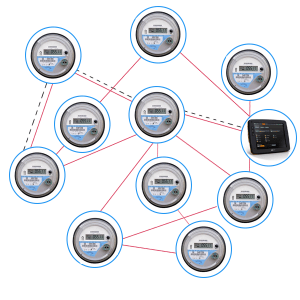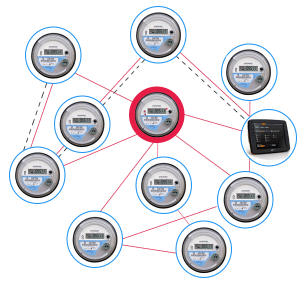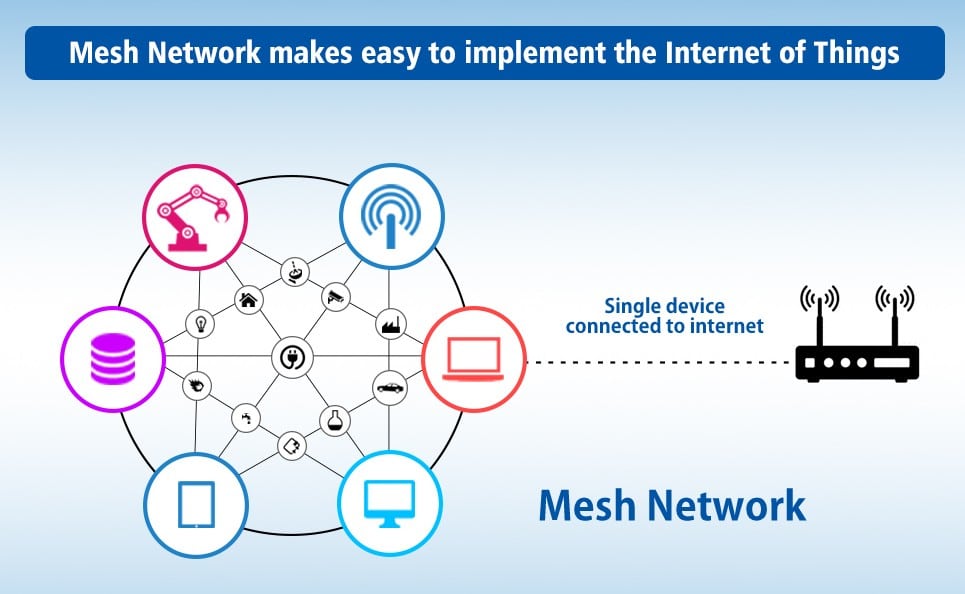How mesh works
A mesh network has every single node connected to multiple nodes. All these nodes transmit packets wirelessly and they are in range of each other. This ensures packets transmitted by one node is received by multiple nodes. The packets received are then forwarded, until they reach their expected destination. As there are multiple copies of the same packet in the network, the chances of the packet reaching its destination are quite high, even if individual nodes in the network fail. The probability of packets reaching their destination is also increased because mesh networks do not have fixed paths for packet hopping. Failure of nodes does not result in the network crashing. A single point of failure can occur if the mesh network works on the coordinator router architecture like the ZigBee network. This means that if the coordinator of a network fails then the whole network crashes and you are back to square one.


New nodes can be added to the network without facing hiccups. These nodes add themselves to the network without much effort and begin transmitting and receiving data just like the remaining network. This is the self-forming feature of the mesh network. Adding new nodes does not affect the remaining nodes. However, each protocol has its own limit of nodes that it can handle. For example, the ZigBee mesh can handle around 100 nodes per network.
Mesh implementation comes with advantages…
Self-healing. In case one node malfunctions, the packets re-routes on its own to reach the appropriate destination.
End-to-end reach. The range of the mesh can be extended up to multiple kilometers with the use of appropriate algorithms and technology.
Scalable. New nodes can be easily added to the network without disturbing the existing architecture.
Adaptable. The mesh network can be adapted to a wide variety of networks from where we want to get data. This includes networks for home automation, smart lighting, street lighting, smart metering, medical wearables and industrial automation.
…and disadvantages
Architecture. The architecture of the mesh network differs from protocol to protocol. As a result each protocol comes with its own sets of disadvantages. To add to it, most protocols are not interoperable with each other. This results in having to deploy a single mesh and then finding if it suits you or not. For example, the ZigBee mesh has coordinator router architecture. This means that there is one coordinator per network that has multiple routers. On the other hand, the DigiMesh protocol has only routers in the network and there are no coordinators. Needless to say, these two protocols are not interoperable. Each protocol has its own set of benefits and drawbacks.
Redundancy. There is a high redundancy in the amount of data that is sent and received in the mesh. Algorithms are needed to effectively manage this redundancy, otherwise it affects the speed of the network. This limits the area of usage of the mesh protocol. For example, sensor or meter data can be collected without much hassle, but audio or video data cannot be transferred by mesh network; at least not the current implementations of mesh network.
Lack of interoperability. Different mesh algorithms do not work with each other. For example, ZigBee protocol will not work with DigiMesh, which will not work with Smartt Mesh. This does not let the same network use different protocols. This means if you have implemented DigiMesh for home automation then you cannot use ZigBee based sensors.
Implementations in IoT
The mesh network can be used in multiple scenarios as talked about in the advantages. Here we will throw light on two completely different scenarios.
Let’s take the example of medical wearables. Assume that these are battery operated devices monitoring the patient’s heartbeats. These sensors would be spread across the floor of a hospital, each with a unique ID to identify the patient in question and the data about the heartbeats. A mesh network would help in collecting data and transferring them to a central location to be monitored by a doctor, intern or nurse. Even if the patients moved about on the floor, the data would form new routes and reach the server. A central monitoring station would mean that the person who is monitoring the patients would not have to move about. Also, this data can be backed up on the cloud in order to maintain the history of the patient’s condition. Thus the mesh network now becomes the best method of communication for remote monitoring of patient data.
This is another example for industrial automation. Large industries have a wide variety of human operated or automatic machines that communicate with each other continuously. Needless to say, wiring becomes a huge hassle in industries. To top it off, laying down new wires is an equally tough task. A mesh network can be successfully deployed here in order to enable the machines to communicate wirelessly. High range technology along with repeaters would help in overcoming the solid metal obstacles that would hamper communication. There would be no cost of extra wiring and communication would happen without change of the protocol of the machine. Once again, the status and the data of all the machines could be monitored from a central server. All this data could be uploaded to the cloud in order to give remote monitoring capabilities.
Mesh network will undoubtedly be the future of IoT communication
So, what does this mean for the networking domain in general and the machine to machine (M2M)/IoT field specifically? Mesh network is without a doubt the future of computer networking. The M2M/IoT domain uses a large number of sensors to collect and upload data to the internet. Mesh network is an efficient way to do it. The future will progress in the direction of interoperability and battery efficiency.
At the present moment, there is no single standard for mesh network and going forward this will have to change if we are to collect vast amounts of data and upload it on the Internet. As sensors will be battery operated, the power management and energy efficiency part will play a big role in the mesh algorithms of the future. A winning combination of mesh algorithm will be one that can be truly plug-n-play using nothing more that market bought components, replete with collision management algorithms, power management features and user friendly user interface similar to most of the websites on the Internet.
About the authors
Devavrat Kulkarni is a Senior Business Analyst and Dhananjay Kulkarni is COO of Maven Systems Pvt. Ltd. The contents or opinions in this feature are independent and may not necessarily represent the views of EFY. They are offered in an effort to encourage continuing conversations on IoT and technologies around it. We welcome your comments and engagement.
About Maven Systems
Maven Systems Pvt. Ltd. is an end-to-end product development company working in the M2M / IoT field. Maven’s area of expertise is wireless communication for a wide spectrum of domains. Maven has developed products for smart lighting, home automation, smart metering, medical wearables, industrial automation, asset monitoring and heavy equipment monitoring. Maven’s proprietary Smartt Mesh protocol, won the Parivartan Sustainability Award 2014. With clients in 18 different countries, Maven has a global reach.














